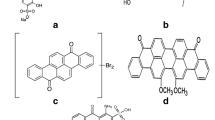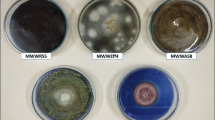ABSTRACT
Concern for the incorrect disposal of potentially toxic substances in aquatic environments is growing due to adverse effects caused to the organisms exposed to them. Synthetic azo dyes are part of this group of substances, and increasingly, researchers seek alternatives able to degrade and remove these molecules to prevent their discharge to the environment. Thus, this study sought to examine the dye removal capacity Acid Blue 161 by biosorption and biodegradation from filamentous fungi Aspergillus niger and Aspergillus terreus and perform acute toxicity tests with Lactuca sativa organisms and Artemia salina. The biossorption treatment resulted in 46 % decolorization of the solutions and reducing the toxicity of the means for both organisms tested. While the biodegradation study resulted in 84 % decolorization at the end of treatment. The resulting solution of such treatment did not show toxicity to the larvae of A. salina and the L. sativa seeds were increased by 40 % in the inhibition of root growth of seedlings. FTIR studies indicated the presence of amines in the middle, which justifies the increase in toxicity to seedlings, since these compounds are potentially toxic to a variety of organisms.







Similar content being viewed by others
References
Al, G., Özdemir, U., & Aksoy, Ö. (2013) Cytotoxic effects of Reactive Blue 33 on Allium cepa determined using Taguchi’s L8 orthogonal array Ecotoxicology and Environmental Safety, 98, 36-40.
Amin, F., Talpur, F. N., Balouch, A., Surhio, M. A., & Bhutto, M. A. (2015). Biosorption of fluoride from aqueous solution by white-rot fungus Pleurotus eryngii ATCC 90888. Environmental Nanotechnology Monitoring & Management, 3, 30–37.
Arjunan, V., Subramanian, S., & Mohan, S. (2004). FTIR and FTR spectral studies of 2-amino-6-bromo-3-formylchromone. Spectrochimica Acta A, 60, 995–1000.
Athalathil, S., Font, J., Fortuny, A., Stüber, F., Bengoa, C., & Fabregat, A. (2015). New sludge-based carbonaceous materials impregnated with different metals for anaerobic azo-dye reduction. Journal Environmental Chemical Engineering, 3, 104–112.
Ayed, L., Chaieb, K., Cheref, A., & Bakhrouf, A. (2010). Biodegradation and decolorization of triphenylmethane dyes by Staphylococcus epidermidis. Desalination, 260, 137–146.
Ayed, L., Mahdhi, A., Cheref, A., & Bakhrouf, A. (2011). Decolorization and degradation of azo dye Methyl Red by an isolated Sphingomonas paucimobilis: biotoxicity and metabolites characterization. Desalination, 274, 272–277.
Babu, S. S., Mohandass, C., Vijayaraj, A. S., & Dhale, A. M. (2015). Detoxification and color removal of Congo red by a novel Dietzia sp. (DTS26)—a microcosm approach. Ecotoxicology and Environmental Safety, 144, 52–60.
Baêta, B. E. L., Lima, D. R. S., Silva, S. Q., & Aquino, S. F. (2015). Evaluation of soluble microbial products and aromatic amines accumulation during a combined anaerobic/aerobic treatment of a model azo dye. Chemical Engineering Journal, 259, 936–944.
Bedekar, P. A., Saratale, R. G., Saratale, G. D., & Govindwar, S. P. (2014). Development of low cost upflow columm bioreactor for degradation and detoxification of blue HERD and textile effluent by Lysinibacillus sp. RGS immobilized on Loofa. International Biodeterioration & Biodegradation, 96, 112–120.
Couto, S. R. (2009). Dye removal by immobilised fungi. Biotechnology Advances, 27, 227–235.
Du, L. N., Wang, B., Li, G., Wang, S., Crowley, D. E., & Zhao, Y. H. (2012). Biosorption of the metal-complex dye Acid Black 172 by live and heat-treated biomass of Pseudomonas sp. strain DY1: kinetics and sorption mechanisms. Journal of Hazardous Materials, 205–206, 47–54.
Fanchiang, J. M., & Tseng, D. H. (2009). Degradation of anthraquinone dye C.I. Reactive Blue 19 in aqueous solution by ozonation. Chemosphere, 77, 214–221.
Guendouz, S., Khellaf, N., Zerdaoui, M., & Ouchefoun, M. (2013). Biosorption of synthetic dyes (Direct Red 89 and Reactive Green 12) as an ecological refining step in textile effluent treatment. Environmental Science and Pollution Research, 20, 3822–3829.
Horvat, A. J. M., Petrovic, M., Babics, S., Pavlovic, D. M., Asperger, D., Pelko, S., Mance, A. D., & Kastelan-Macan, M. (2012). Analysis, occurrence and fate anthelmintcs and their transformation products in the environment. Trends in Analytical Chemistry, 31, 61–24.
Imran, M., Arshad, M., Negm, F., Khalid, A., Shaharoona, B., Hussain, S., Nadeem, S. M., & Crowley, D. E. (2016). Yeast extract promote decolorization of azo dyes by stimulating azoreductase activity in Shewanella sp, strain IFN 4. Ecotoxicology and Environmental Safety, 124, 42–49.
Isik, M., & Sponza, D. T. (2007). Fate and toxicity of azo dye metabolites under batch long-term anaerobic incubations. Enzyme and Microbial Technology, 40, 934–939.
Kabbout, R., & Taha, S. (2014). Biodecolorization of textile dye effluent by biosorption of fungal biomass materials. Physics Procedia, 55, 437–444.
Marcanti-Contato, I., Corso, C. R., & Oliveira, J. E. (1997). Induction of physical paramorfogenesis in Aspergillus sp. Revista de Microbiologia, 28, 65–67.
Olukanni, O. D., Osuntoki, A. A., Kalyani, D. C., Gbenle, G. O., & Govindwar, S. P. (2010). Decolorization and biodegradation of Reactive Blue 13 by Proteus mirabilis LAB. Journal of Hazardous Materials, 184, 290–298.
Pakshirajan, K., Sivasankar, A., & Sahoo, N. K. (2011). Decolourization of synthetic wastewater containing azo dyes by immobilized Phanerochaete chrysosporium in a continuously operated RBC reactor. Applied Microbiology and Biotechnology, 89, 1223–1232.
Rathod, J., & Archana, G. (2013). Molecular fingerprinting of bacterial communities in enriched azo dye (Reactive Violet 5R) decolorising native acclimatised bacterial consortia. Bioresourse Technology, 142, 436–444.
Sobrero, M. S., & Ronco, A. (2008). Ensayo de toxidad aguda con semillas de lechuga Lactuca sativa L. Ensayos toxicológicos pra la evalucion de susbstancias químicas en agua y suelo, 1, 55–68.
Acknowledgments
Support from the Brazilian fostering agencies FAPESP/Brazil, CAPES/Brazil, CNPq/Brazil and Fundunesp/Brazil.
Author information
Authors and Affiliations
Corresponding author
Rights and permissions
About this article
Cite this article
de Almeida, E.J.R., Corso, C.R. Acid Blue 161: Decolorization and Toxicity Analysis After Microbiological Treatment. Water Air Soil Pollut 227, 468 (2016). https://doi.org/10.1007/s11270-016-3042-5
Received:
Accepted:
Published:
DOI: https://doi.org/10.1007/s11270-016-3042-5




